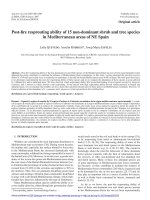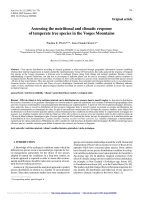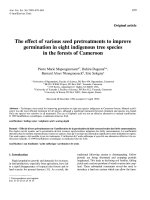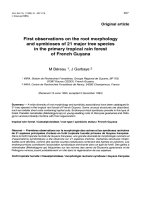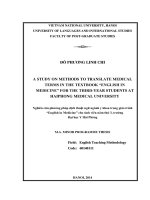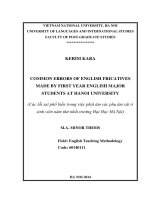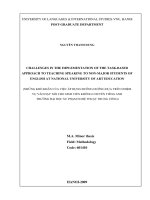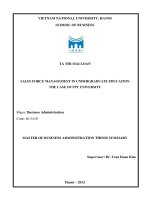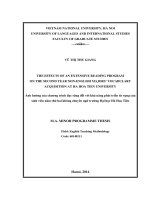- Trang chủ >>
- THPT Quốc Gia >>
- Ngữ Văn
Fuelwood characteristics of some important tree species in prevalent agroforestry systems of district Budgam, Kashmir Valley, India - Trường Đại học Công nghiệp Thực phẩm Tp. Hồ Chí Minh
Bạn đang xem bản rút gọn của tài liệu. Xem và tải ngay bản đầy đủ của tài liệu tại đây (227.04 KB, 6 trang )
<span class='text_page_counter'>(1)</span><div class='page_container' data-page=1>
<i><b>Int.J.Curr.Microbiol.App.Sci (2017) 6(11): 3801-3806 </b></i>
3801
<b>Original Research Article </b>
<b>Fuelwood Characteristics of Some Important Tree Species in Prevalent </b>
<b>Agroforestry Systems of District Budgam, Kashmir Valley, India </b>
<b>Sabeena Nabi1*, K.N. Qaisar1, Shabir Ahmad Rather1, P.A. Khan1 and Burhan Nabi2</b>
1
Faculty of Forestry, SKUAST-K, Benhama, Ganderbal-191201 (J&K), India
2
Division of Veterinary Medicine, SKUAST-J-180009, India
<i>*Corresponding author </i>
<i><b> </b></i> <i><b> </b></i><b>A B S T R A C T </b>
<i><b> </b></i>
<b>Introduction </b>
Fuelwood is the major tangible benefit to the
farmers through agroforestry systems. Their
ranking in terms of quantitative values is
equally important to evaluate/assess the
potential trees for fuelwood needs of the
farmers. Fuelwood is the largest energy
source for the three-quarters of the world’s
population who live in developing countries
(Scurlock and Hall, 1990).
Indeed, the demand for fuelwood is likely to
continue as the most important energy source
for rural areas of many countries (Deka <i>et al.,</i>
2007). The contribution of fuelwood to the
total energy consumed varies from place to
place and is mainly determined by the level of
development and availability (Kumar <i>et al.,</i>
2011). According to one estimate, about half
of all energy (commercial and biomass)
consumed is used for cooking food, which is
nearly double the energy (fossil fuel and
electricity) used by the agriculture and
industrial sector combined together (Bhatt <i>et </i>
<i>al.,</i> 2010).
Keeping this fact in view, the present study
was designed to screen out some broad leaved
and fruit trees present in various prevalent
agroforestry systems for fuelwood farming in
terms of firewood properties.
<i>International Journal of Current Microbiology and Applied Sciences </i>
<i><b>ISSN: 2319-7706</b></i><b> Volume 6 Number 11 (2017) pp. 3801-3806 </b>
Journal homepage:
Quantitative analysis of five (05) broad leaved and four (04) fruit tree
species viz., <i>Populus deltoides</i>, <i>Populus nigra</i>, <i>Robinia pseudoacacia</i>, <i>Salix </i>
<i>alba</i>, <i>Salix fragilis</i>, <i>Malus domestica</i>, <i>Prunus domestica</i>, <i>Prunus dulcis </i>and
<i>Pyrus communis </i>respectively was carried out to present the possibility of
pruned biomass from broad leaved and fruit cultivars for firewood
production. Pruning’s/wood samples of various trees were collected from
four prevalent agroforestry systems of District Budgam of Kashmir valley
viz., Boundary plantation, Homegarden, Horti-agricultural and
Horti-silvi-pasture system. The results of the investigation revealed that <i>Robinia </i>
<i>pseudoacacia</i> elucidated highest FVI as 948.05 and <i>Prunus dulcis </i> as
1067.42 among broad leaved and fruit trees species respectively.
<b>K e y w o r d s </b>
FVI, Broad leaved
species, Fruit trees,
agroforestry systems,
Kashmir valley.
<i><b>Accepted: </b></i>
28 September 2017
<i><b>Available Online:</b></i>
</div>
<span class='text_page_counter'>(2)</span><div class='page_container' data-page=2>
<i><b>Int.J.Curr.Microbiol.App.Sci (2017) 6(11): 3801-3806 </b></i>
3802
<b>Materials and Methods </b>
<b>The study site</b>
The site selected for the present study was
District Budgam in Kashmir valley, India
with pruned tree biomass collected from most
preferred broad leaved and fruit tree species
present in four (04) prevalent agroforestry
systems of District Budgam i.e., Boundary
plantation, Homegarden, Horti-agricultural
and Horti-silvi-pasture system. The climate is
of the temperate type with the upper-reaches
receiving heavy snowfall in winter. The
average annual precipitation of the district is
585 mm.
<b>Sampling procedure </b>
A total of three tehsils namely: Budgam,
Beerwah and Chadoora were selected to carry
out the above mentioned research problem in
District Budgam. Multistage stratified random
sampling was used to select the blocks;
villages within tehsils and then farmers within
villages (Table 1). A total of 252 farmers
were selected and interviewed through
pre-tested questionnaire regarding different land
use patterns (agriculture, agroforestry,
horticulture), components of land use systems
and their socio-economicstatus. After
reconnaissance, four agroforestry systems
were identified as prevalent viz., Boundary
plantation, Homegarden, Horti-agricultural
system and Horti-silvi-pasture system. Nine
tree species were identified as most important
tree components of these prevalent
agroforestry systems of District Budgam
namely: <i>Populus deltoides</i>, <i>Populus nigra</i>,
<i>Robinia pseudoacacia</i>, <i>Salix alba</i>, <i>Salix </i>
<i>fragilis</i>, <i>Malus domestica</i>, <i>Prunus domestica, </i>
<i>Prunus dulcis</i> and <i>Pyrus communis</i>. Ten
randomly selected branch cuttings (2–3 cm
diameter) of <i>Populus deltoides</i>, <i>Populus </i>
<i>nigra</i>, <i>Robinia pseudoacacia</i>, <i>Salix alba</i>,
<i>Salix fragilis</i>, <i>Malus domestica</i>, <i>Prunus </i>
<i>domestica, </i> <i>Prunus </i> <i>dulcis </i> and <i>Pyrus </i>
<i>communis </i> were collected during autumn
2013-14 from prevalent agroforestry systems
using stratified random sampling and a
composite sample was made. These were
divided into four replicates of 10 cm length
(Bhatt and Todaria, 1992a; Bhatt <i>et al.,</i> 2010)
and put immediately in polyethylene bag and
sealed to avoid moisture loss. Wood samples
of all the tree species, thus collected were
transferred to the laboratory for determination
of their various properties. Wood moisture
content (%) was determined after drying it at
100±50 C for 48 hr (Bhatt and Badoni, 1990).
Wood density (g/cc) was calculated using the
water displacement technique (Purohit and
Nautiyal, 1987). Wood samples were ground
in a mechanical grinderand pelleted to
determine their calorific values. To estimate
the energy of wood samples, pellets of known
weight (1gm) of plant material were burned in
an oxygen bomb calorimeter (Bhatt and
Bhadoni, 1990). For the estimation of ash
content (%), 2 gm of ground sample was
burned in a muffle furnace at 600 0C for 3 hrs
following the method given by Purohit and
Nautiyal (1987) and Bhatt and Todaria
(1992a).
<b>Statistical analysis </b>
All data were subjected to analysis of
variance (ANOVA) using R- software. Means
were separated using the comparisons based
upon the least significant difference (LSD)
(Level of significance P<0.05).
<b>Results and Discussion </b>
<b>Wood moisture content (%)</b>
</div>
<span class='text_page_counter'>(3)</span><div class='page_container' data-page=3>
<i><b>Int.J.Curr.Microbiol.App.Sci (2017) 6(11): 3801-3806 </b></i>
3803
observed in <i>Populus deltoides</i> (64.63%)
which was at par with <i>Populus nigra</i>, <i>Salix </i>
<i>alba</i> and <i>Salix fragilis</i>. Whereas, minimum
moisture percentage was evaluated in <i>Robinia </i>
<i>pseudoacacia </i> (59.07%). Among fruit trees,
<i>Pyrus communis </i> recorded higher wood
moisture per cent of 47.40 and <i>Prunus dulcis</i>
recorded lower moisture content of 34.25 %
(Tables 2 and 3). Moisture in wood generally
decreases its calorific value, which is
established by a number of investigators
(Saravannan <i>et al.,</i> 2013). Effective calorific
value also depends on the moisture content.
The higher the moisture content, the less
efficient is the wood as a fuel since the net
calorific value for heating is reduced (Bhatt <i>et </i>
<i>al.,</i> 2010; Bhatt <i>et al.,</i> 2004). Moreover, it has
been recorded that the moisture content of
wood varies with the dimensions of branches,
season of the year, and so on. Thus, water
content cannot be considered as part of the
intrinsic value of a species as a fuel since it
can vary (Sotelo Montes <i>et al.,</i> 2011; Bhatt
and Todaria, 1992b).
<b>Wood density (g/cc) </b>
Wood density plays an important role in
biomass energy. A critical view of the data in
Tables 2 and 3 explicated a significant
difference in wood densities among the
species. As far as broad leaved species are
concerned, maximum wood density was
found to be 0.64 g/cc in <i>Robinia </i>
<i>pseudoacacia</i> and minimum value of 0.41
g/cc in <i>Populus deltoides</i>. In fruit trees,
maximum wood density was recorded in
<i>Prunus dulcis</i> (0.89 g/cc) and minimum in
<i>Prunus domestica</i> (0.66 g/cc) which was at
par with <i>Pyrus communis</i> and <i>Malus </i>
<i>domestica</i>. An ideal fuel wood species should
have high calorific value coupled with high
wood density and low ash content. The results
of the present investigation are in conformity
with the earlier findings of Kumar <i>et al.,</i>
(2011), Purohit and Nautiyal (1987) and Bhatt
and Todaria (1992b).
<b>Ash content (%) </b>
Results of the present investigation elaborate
the non-significant and significant differences
among broad leaved and fruit treespecies
respectively in terms of ash content. In broad
leaved trees, maximium ash content was
recorded in <i>Populus deltoides</i> (1.48%) with
minimum content in <i>Robinia pseudoacacia </i>
(1.19%) (Table 2).
Likewise in fruit trees, <i>Pyrus communis</i> had
maximum ash content of 1.98% and minimum
of 1.55% in <i>Malus domestica </i>(Table 3). High
wood ash content is less desirable for fuel, as
it is non-combustible, and reduces the heat of
combustion. The findings of present study are
in concurrence with Goel and Behl (1996) and
Bhatt and Tomar (2002).
<b>Table.1 </b>Details/ Methodology for the selection of sample areas
<b>Selected Tehsils </b> <b>Beerwah </b> <b>Budgam </b> <b>Chadoora </b>
Selected Blocks (06) 2 2 2
Selected Villages (06 per Block) 6 x 2 = 12 6 x 2 = 12 6 x 2 = 12
Selected Farmers (7 per Village) 6 x 2 x 7 = 84 6 x 2 x 7 = 84 6 x 2 x 7 = 84
</div>
<span class='text_page_counter'>(4)</span><div class='page_container' data-page=4>
<i><b>Int.J.Curr.Microbiol.App.Sci (2017) 6(11): 3801-3806 </b></i>
3804
<b>Table.2 </b>Evaluation of fuelwood values of important tree species of District Budgam (Kashmir valley)
<b>Plant species </b> <b>Wood moisture </b>
<b>content (%) </b>
<b> Wood density </b>
<b>(g/cc) </b>
<b>Ash content </b>
<b>(%) </b>
<b>Calorific value </b>
<b>(KJ/gm) </b>
<b>Fuelwood Value </b>
<b>Index (FVI) </b>
<i>Populus deltoides </i> 64.63 0.41 1.48 18.53 513.33
<i>Populus nigra </i> 63.02 0.42 1.48 18.55 526.41
<i>Robinia pseudoacacia </i> 59.07 0.64 1.50 22.22 948.05
<i>Salix alba </i> 63.34 0.46 1.45 19.38 614.81
<i>Salix fragilis </i> 63.41 0.46 1.46 19.37 610.28
<b>Mean </b> 62.72 0.51 1.47 19.61 642.57
<b>CD (p≤0.05) </b> 1.19 0.04 N.S 1.16 345.00
<b>Table.3 </b>Evaluation of fuelwood values of important fruit tree species of District Budgam (Kashmir valley)
<b>Plant species </b> <b>Wood moisture </b>
<b>content (%) </b>
<b>Wood density </b>
<b>(g/cc) </b>
<b>Ash content </b>
<b>(%) </b>
<b>Calorific value </b>
<b>(KJ/gm) </b>
<b>Fuelwood Value </b>
<b>Index (FVI) </b>
<i>Malus domestica </i> 42.09 0.81 1.55 16.54 864.34
<i>Prunus domestica </i> 46.69 0.66 1.57 16.19 738.26
<i>Prunus dulcis </i> 34.25 0.89 1.56 18.71 1067.42
<i>Pyrus communis </i> 47.40 0.67 1.98 15.54 525.84
<b>Mean </b> 42.60 0.75 1.66 16.75 828.95
</div>
<span class='text_page_counter'>(5)</span><div class='page_container' data-page=5>
<i><b>Int.J.Curr.Microbiol.App.Sci (2017) 6(11): 3801-3806 </b></i>
3805
<b>Calorific value (KJ/gm) </b>
Perusal of the data on fuelwood properties
explicated that there exist significant variation
among evaluated tree species (Tables 2 and
3). In broad leaved trees, <i>Robinia </i>
<i>pseudoacacia</i> exhibited highest calorific
value (22.22 KJ/gm), followed by <i>Salix alba </i>
(19.38 KJ/gm) which was found to be at par
with <i>Salix fragilis</i> (19.37 KJ/gm), <i>Populus </i>
<i>deltoids </i> (18.53 KJ/gm) and <i>Populus nigra</i>
(18.55 KJ/gm) (Table 2). However, among
fruit tree species (Table 3), the highest energy
value of 18.71 KJ/gm was recorded for
<i>Prunus dulcis </i>followed by <i>Malus domestica</i>
(16.54 KJ/gm) with lowest value evaluated
for <i>Pyrus communis </i> (15.54 KJ/gm) which
was found to be at par with <i>Malus domestica</i>
(16.54 KJ/gm) and <i>Prunus </i> <i>domestica </i>
(16.19KJ/gm). The present study findings are
in conformity with Cuvilas <i>et al.,</i> (2014) and
Obernberger <i>et al.,</i> (2006). Effective calorific
value also depends on the moisture content,
wood density and ash content. The higher the
moisture and ash content, the less efficient is
the wood and vice-versa (Bhatt <i>et al.,</i> 2010,
Kumar <i>et al.,</i> 2010 and Bhatt <i>et al.,</i> 2004).
<b>Fuel Wood Value Index (FVI) </b>
For estimation of ideal fuelwood species, a
fuelwood value index (FVI) was calculated as
calorific value x density/ash (Bhatt and
Todaria, 1992b). Data pertaining to fuelwood
index value (Tables 2 and 3) revealed that all
the species viz., broad leaved trees and fruit
trees showed marked difference with respect
to FVI. In broad leaved species, maximum
fuelwood value index was observed in
<i>Robinia pseudoacacia </i>(948.05) followed by
<i>Salix alba </i> (614.81). However, minimum
value of (513.33) was recorded in <i>Populus </i>
<i>deltoides. </i>Likewise, among fruit trees, <i>Prunus </i>
<i>dulcis</i> (1067.42) recorded highest fuelwood
value index followed by <i>Malus domestica</i>
(864.34) and lowest by <i>Pyrus communis </i>
(525.84). For determination of suitability of a
wood as fuel, a combination of three factors
viz., calorific value, density, and ash will be
most appropriate as stated by Saravanan <i>et al., </i>
(2013) in <i>Melia dubia</i>, Deka<i> et al., </i>(2007) for
ranking fuelwood species of Assam, Goel and
Behl (1996) in <i>Acacia auriculiformis</i>, <i>Acacia </i>
<i>nilotica</i>, <i>Prosopis juliflora </i> and <i>Terminalia </i>
<i>arjuna</i> and Jain (1994) in tree and shrub
species of India.
In conclusion, the results of the current study
indicates that <i>Robinia pseudoacacia</i> among
broad leaved <i>Prunus dulcis</i> among fruit trees
are amenable source of fire wood production
due to their ideal energy values. Extensive
farming of <i>Robinia pseudoacacia</i> and <i>Prunus </i>
<i>dulcis</i> under scientific supervision particularly
for <i>Robinia pseudoacacia</i> for firewood
production could bridge the gap between the
demand and supply which people are facing
today.
<b>Acknowledgement </b>
The first author gratefully acknowledge the
financial support (INSPIRE- Fellowship)
provided by the Department of Science and
Technology, Government of India, New Delhi
during pursuit of this study.
<b>References </b>
Bhatt, B.P. and Bhadoni, A.K. 1990. Fuel
characteristics of some mountain fire
wood shrubs and trees. <i>Energy</i>, 15:
1069-1070.
Bhatt, B.P. and Todaria, N.P. 1992a. Fire
wood characteristics of some mountain
trees and shrubs. <i>Commonwealth </i>
<i>Forestry Review</i>,71(3/4): 183-185.
Bhatt, B.P. and Todaria, N.P. 1992b.
</div>
<span class='text_page_counter'>(6)</span><div class='page_container' data-page=6>
<i><b>Int.J.Curr.Microbiol.App.Sci (2017) 6(11): 3801-3806 </b></i>
3806
Bhatt, B.P. and Tomar, J.M.S. 2002.
Firewood properties of some Indian
mountain tree and shrub species.
<i>Biomass and Bioenergy</i>, 23: 257-260.
Bhatt, B.P., Sarangi, S.K. and De, L.C. 2010.
Fuelwood characteristics of some
firewood trees and shrubs of Eastern
Himalaya, India. <i>Energy </i> <i>Sources</i>,
32(A): 469-474.
Bhatt, B.P., Tomar, J.M.S. and Bujarbaruah,
K.M. 2004. Characteristics of some
firewood trees and shrubs of the North
Eastern Himalayan region, India.
<i>Renewable Energy, </i>29: 1401–1405.
Cuvilas, C., Lhate, I., Jirjis, R. and Terziev,
N. 2014. The characterization of wood
species from Mozambique as a fuel.
<i>Energy Sources</i>, 36(A): 851-857.
Deka, D., Saikia, P. and Konwer, D. 2007.
Ranking of fuelwood species by fuel
value index. <i>Energy Sources</i>, 29(A):
1499-1506.
Goel, V.L. and Behl, H.M. 1996. Fuelwood
quality of promising species for alkaline
soil sites in relation to tree age. <i>Biomass </i>
<i>and Bioenergy</i>, 10(1): 57-61
Jain, R.K. 1994. Fuelwood characteristics of
medium tree and shrub species of India.
<i>Bioresource Technology</i>, 47: 81-84.
Kumar, M., Patel, S.K. and Mishra, S. 2010.
Studies on characteristics of some
shrubaceous non- woody biomass
species and their electricity generation
potentials. <i>Energy Sources</i>, 32:786-795.
Kumar, N.J.I., Patel, K., Rita, N.K. and Rohit,
K.B. 2011. An evaluation of fuelwood
properties of some Aravally mountain
tree and shrub species of western India.
<i>Biomass and Bioenergy, </i>35: 411-414.
Obernberger, I., Brunner, T. and Barnthaler,
G. 2006. Chemical properties of solid
biofuels- significance and impact.
<i>Biomass and Bioenergy</i>,30: 973–982.
Purohit, A.N. and Nautiyal, A.R. 1987.
Fuelwood value index of Indian
mountain tree species. <i>The International </i>
<i>Tree Crops Journal</i>,4: 177-182.
Saravanan, V., Parthiban, K.T., Kumar, P.,
Anbu, P.V. and Ganesh Pandian, P.
2013. Evaluation of fuel wood
properties of <i>Melia dubia </i>at different
age gradation. <i>Research Journal of </i>
<i>Agriculture and Forestry Sciences</i>,1(6):
8-11.
Scurlock, J.M.O. and Hall, D.O. 1990. The
contribution of biomass to global
energy use. <i>Biomass</i>,21: 75-81.
Sotelo Montes, C., Weber, J.C., Silva, D.A.,
Andrade, C., Muniz, G.I.B., Garcia,
R.A. and Kalinganire, A. 2014. Growth
and fuelwood properties of five tree and
shrub species in the Sahelian and
Sudanian ecozones of Mali:
relationships with mean annual rainfall
and geographical coordinates. <i>New </i>
<i>Forests</i>,45:179-197.
<b>How to cite this article: </b>
</div>
<!--links-->
Báo cáo lâm nghiệp: "Soil characteristics under selected broadleaved tree species in East Norwa" docx
- 12
- 313
- 0
